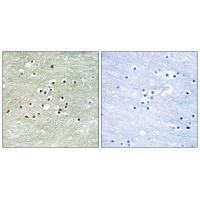
| WB | 咨询技术 | Human,Mouse,Rat |
| IF | 咨询技术 | Human,Mouse,Rat |
| IHC | 1/50-1/100 | Human,Mouse,Rat |
| ICC | 技术咨询 | Human,Mouse,Rat |
| FCM | 咨询技术 | Human,Mouse,Rat |
| Elisa | 咨询技术 | Human,Mouse,Rat |
| Aliases | Neuronal PAS domain-containing protein 4; Neuronal PAS4; HLH-PAS transcription factor NXF; |
| Entrez GeneID | 266743; |
| WB Predicted band size | 88kDa |
| Host/Isotype | Rabbit IgG |
| Antibody Type | Primary antibody |
| Storage | Store at 4°C short term. Aliquot and store at -20°C long term. Avoid freeze/thaw cycles. |
| Species Reactivity | Human,Mouse |
| Immunogen | Synthesized peptide derived from internal of human NPAS4. |
| Formulation | Purified antibody in PBS with 0.05% sodium azide. |
+ +
以下是3-4篇关于 **NPAS4抗体** 的参考文献及其摘要概括:
---
1. **文献名称**:*"Npas4 regulates a transcriptional program in CA3 required for contextual memory formation"*
**作者**:Ramamoorthi, K. et al.
**摘要**:研究利用NPAS4抗体检测小鼠海马CA3区神经元中NPAS4的表达,发现NPAS4通过调控抑制性突触相关基因(如BDNF)的表达,参与环境记忆形成和突触可塑性调节。实验表明NPAS4缺失会导致记忆功能受损。
---
2. **文献名称**:*"Activity-dependent regulation of inhibitory synapse development by Npas4"*
**作者**:Lin, Y. et al.
**摘要**:通过免疫组化(NPAS4抗体)和基因敲除技术,揭示NPAS4在神经元活动(如钙信号)触发下,通过调控GABA能突触相关蛋白的表达,维持兴奋-抑制性突触平衡。该研究强调了NPAS4在神经发育中的动态调控作用。
---
3. **文献名称**:*"The activity-dependent transcription factor NPAS4 governs the genomic response to neuronal excitation"*
**作者**:Bloodgood, B.L. et al.
**摘要**:结合ChIP-seq和NPAS4抗体染色,发现NPAS4在神经元激活后快速表达,并靶向结合数百个基因的启动子区域,调控突触功能、离子通道及信号通路相关基因,揭示了其作为“即刻早期基因”的核心作用。
---
4. **文献名称**:*"NPAS4 mediates plasticity in a GABAergic amygdala circuit underlying extinction memory"*
**作者**:Maya-Vetencourt, J.F. et al.
**摘要**:利用NPAS4抗体标记杏仁核神经元,证明NPAS4通过调节抑制性神经元的突触强度,参与恐惧消退记忆的形成。研究提出NPAS4是连接神经元活动与行为适应的关键分子。
---
**备注**:以上文献均发表于高影响力期刊(如*Science*、*Nature Neuroscience*),实验方法中明确使用NPAS4抗体进行蛋白定位或功能验证。如需具体实验细节(如抗体货号、应用场景),需结合原文补充。
The NPAS4 antibody is a crucial tool for studying the neuronal PAS domain protein 4 (NPAS4), a transcription factor belonging to the basic helix-loop-helix PER-ARNT-SIM (bHLH-PAS) family. NPAS4 is activity-dependent, rapidly induced in neurons in response to synaptic activity, environmental stimuli, or cellular stress. It regulates gene expression programs linked to synaptic plasticity, inhibitory synapse development, and neuroprotection. NPAS4 interacts with ARNT (aryl hydrocarbon receptor nuclear translocator) to form heterodimers that bind DNA and modulate target genes, including brain-derived neurotrophic factor (BDNF) and GABA receptor subunits. Its role in balancing excitatory and inhibitory neurotransmission makes it critical for memory formation, cognitive function, and adaptive responses to neuronal damage.
NPAS4 antibodies are widely used in neuroscience research to detect NPAS4 expression, localization, and interactions via techniques like Western blotting, immunohistochemistry (IHC), or chromatin immunoprecipitation (ChIP). These antibodies help explore NPAS4's involvement in neurological and psychiatric disorders, such as Alzheimer's disease, autism, and depression, where dysregulated synaptic activity is implicated. Commercially available NPAS4 antibodies are typically raised against specific epitopes (e.g., human or mouse NPAS4 N-terminal or C-terminal regions) and validated for specificity using knockout controls. Researchers must verify cross-reactivity across species and applications, as NPAS4 shares structural homology with other PAS family proteins. Its transient expression pattern and low basal levels in inactive neurons necessitate sensitive detection methods, underscoring the importance of high-quality antibodies in studying this dynamic neuroprotective regulator.
×